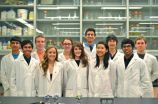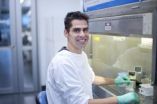(Press-News.org) TEMPE, Ariz. – Diarrheal disease is the second leading cause of death in children under five years old — killing as many as 1.5 million children worldwide every year. These startling statistics from the World Health Organization (2009) point to the reason why a group of undergraduate students from Arizona State University is working to develop a low-cost biosensor — a simple device that would detect contaminated drinking water.
An interdisciplinary team of nine students is participating in the 2012 International Genetically Engineered Machine (iGEM) competition — a prestigious global event that challenges students to design and build simple biological systems made from standard, interchangeable parts.
The ASU team started its research during the summer to prepare for the competition. Its goal is to create a user-friendly, DNA-based biosensor that can detect major pathogens. The low-cost device would be used in the field rather than in a laboratory.
"We are developing a biosensor that will detect pathogenic bacteria, such as Shigella, Salmonella, and E. coli, that cause diarrhea," said Ryan Muller, an undergraduate student in ASU's School of Life Sciences and an iGEM team leader. "Ideally, you would use our biosensor to check different water supplies in third world countries to determine whether the water is safe to drink."
The team is working on two biosensor designs.
"The first one targets DNA," explained Nisarg Patel, a molecular biosciences and biotechnology major in School of Life Sciences, as well as a political science major. "Since each type of pathogen has different DNA, we want to create complementary sequences — sequences that match a specific DNA. We will take bacterial samples from the water, pull out the DNA and check whether it complements our DNA probe. If it does, it will produce a color response and then we'll know that the water is contaminated."
Made for portability, Patel said the second design tests the membranes of bacteria. When using the device to test water, if certain proteins attach to a bacterial membrane, the sample will turn blue — indicating the water is contaminated with a pathogen and would not be safe to drink.
"The advantage of this design over previous designs in the field lies in the cheap production of probes and the enzymatic chain reaction," said Abhinav Markus, a biomedical engineering student in Ira A Fulton Schools of Engineering. "Samples can be tested in the field with minimal cost and high sensitivity."
When the ASU iGEM team first met this summer, Madeline Sands, an anthropology major in the university's School of Human Evolution and Social Change, pitched the idea to build a low-cost biosensor. Sands previously traveled to Guatemala as part of an ASU field experience. There, she conducted community health research under the direction of Jonathan Maupin, a medical anthropologist. Sands realized that contaminated water presents a serious health problem for developing countries.
"With constant earthquakes, landslides and rains in Guatemala, it can often be difficult to determine if a water source is contaminated," said Sands. "My time there made it clear that having a way to detect contaminated water could lead to a further reduction in the incidence and morbidity of diarrhea."
In October, the team will present its device during the iGEM regional competition at Stanford University. If successful, they will move on to the global competition in November at Massachusetts Institute of Technology.
INFORMATION:
Other ASU iGEM team members include: Rohit Rajan, Ethan Ward, Hyder Hussain, Amanda Ispas, and Ellen Qin. Kylie Standage-Beier, a biological sciences major and previous iGEM team member, serves as an advisor.
Arizona State University iGEM team sponsors include School of Life Sciences; Barrett, The Honors College; Ira A. Fulton Schools of Engineering; School of Biological Health Systems and Engineering; College of Liberal Arts and Sciences; School of Politics and Global Studies; and Departments of Chemistry and Biochemistry.
Students create low-cost biosensor to detect contaminated water in developing nations
ASU undergraduate team contender in global synthetic biology competition
2012-09-06
ELSE PRESS RELEASES FROM THIS DATE:
Moderate voices muted in political news
2012-09-06
Los Angeles, CA (September 6, 2012) While commentators and scholars argue that political groups have become more polarized in the US, a new study finds that moderate political groups are not as well covered in newspaper articles as more radical right and left-wing groups. This study is found in a recent article from Journalism & Mass Communication Quarterly, a SAGE journal and an official journal of the Association for Education in Journalism and Mass Communication.
"Extremes are more intuitively novel, entertaining, and colorful, representing another common news value," ...
Stem-cell-protecting drug could prevent the harmful side effects of radiation therapy
2012-09-06
Radiation therapy is one of the most widely used cancer treatments, but it often damages normal tissue and can lead to debilitating conditions. A class of drugs known as mammalian target of rapamycin (mTOR) inhibitors can prevent radiation-induced tissue damage in mice by protecting normal stem cells that are crucial for tissue repair, according to a preclinical study published by Cell Press in the September issue of the journal Cell Stem Cell.
"We can exploit the emerging findings for the development of new preventive strategies and more effective treatment options ...
Immune cell death safeguards against autoimmune disease
2012-09-06
Researchers at the Walter and Eliza Hall Institute have discovered that a pair of molecules work together to kill so-called 'self-reactive' immune cells that are programmed to attack the body's own organs. The finding is helping to explain how autoimmune diseases develop.
Dr Daniel Gray and colleagues from the institute's Molecular Genetics of Cancer division and the University of Ballarat discovered that the absence of two related proteins, called Puma and Bim, led to self-reactive immune cells accumulating and attacking many different body organs, causing illness. The ...
A family portrait of galaxies
2012-09-06
6 September 2012: Two very different galaxies feature in this family portrait taken by the NASA/ESA Hubble Space Telescope, together forming a peculiar galaxy pair called Arp 116. The image shows the dramatic differences in size, structure and colour between spiral and elliptical galaxies.
Arp 116 is composed of a giant elliptical galaxy known as Messier 60, and a much smaller spiral galaxy, NGC 4647.
Being a typical elliptical galaxy, Messier 60 on its own may not be very exciting to look at, but together with its adjacent spiral friend, the pair becomes a rather interesting ...
Novel therapeutic targets identified for small cell lung cancer
2012-09-06
PHILADELPHIA — Newly discovered molecular differences between small cell lung cancer and nonsmall cell lung cancer have revealed PARP1 and EZH2 as potential therapeutic targets for patients with small cell lung cancer, according to the results of a study published in Cancer Discovery, a journal of the American Association for Cancer Research.
Currently, small cell lung cancer accounts for about 15 percent of lung cancer diagnoses in the United States. Patients with the disease will initially respond to chemotherapy, but almost all will have disease recurrence within a ...
Master gene affects neurons that govern breathing at birth and in adulthood
2012-09-06
HOUSTON - (Sept. 7, 2012) – When mice are born lacking the master gene Atoh1, none breathe well and all die in the newborn period. Why and how this occurs could provide new answers about sudden infant death syndrome (SIDS), but the solution has remained elusive until now.
Research led by Baylor College of Medicine and the Jan and Dan Duncan Neurological Research Institute at Texas Children's Hospital demonstrates that when the gene is lacking in a special population of neurons called RTN (retrotrapezoid nucleus), roughly half the young mice die at birth. Those who survive ...
Scientists create germ cell-supporting embryonic Sertoli-like cells from skin cells
2012-09-06
CAMBRIDGE, Mass. (September 6, 2012) – Using a stepwise trans-differentiation process, Whitehead Institute researchers have turned skin cells into embryonic Sertoli-like cells.
The main role of mature Sertoli cells is to provide support and nutrition to the developing sperm cells. Furthermore, Sertoli cells have been demonstrated to possess trophic properties, which have been utilized for the protection of non-testicular cellular grafts in transplantations. However, mature Sertoli cells are mitotically inactive, and the primary immature Sertoli cells during prolonged ...
Wild bees: Champions for food security and protecting our biodiversity
2012-09-06
Pollinating insects contribute to agricultural production in 150 (84%) European crops. These crops depend partly or entirely upon insects for their pollination and yield. The value of insect pollinators is estimated to be €22 billion a year in Europe. Declines in managed pollinators, such as honeybees, and wild pollinator such bumblebees, solitary bees and hoverflies, are therefore of growing concern as we need to protect food production and the maintain wildflower diversity.
Scientists involved in STEP, a large-scale project funded by the 7th Framework Program (FP7) ...
Study: Married lung cancer patients survive longer than single patients after treatment
2012-09-06
CHICAGO – Sept. 6, 2012. Married patients with locally advanced lung cancer are likely to survive longer after treatment than patients who are single, according to a study by researchers at the University of Maryland Marlene and Stewart Greenebaum Cancer Center in Baltimore. The results of the retrospective study are being presented at the 2012 Chicago Multidisciplinary Symposium in Thoracic Oncology.
The University of Maryland researchers studied 168 patients with Stage III non-small cell lung cancer, the most common type of lung cancer, who were treated with chemotherapy ...
New research: Soluble corn fiber plays important role in gut health and calcium absorption
2012-09-06
Chicago – (Sept. 6, 2012) – Savvy consumers and health professionals know that fibre is an essential nutrient associated with important health benefits, yet barriers such as overall poor tolerance to higher-fibre diets may be why average intake is far less than experts recommend (1). Two new research studies supported by Tate & Lyle, the global provider of specialty food ingredients and solutions, provide further evidence that certain higher-fibre diets can in fact be well-tolerated, and that fibre may play an important role in supporting a healthy gut as well as promoting ...
LAST 30 PRESS RELEASES:
Pandemic ‘beneath the surface’ has been quietly wiping out sea urchins around the world
Tea linked to stronger bones in older women, while coffee may pose risks
School feeding programs lead to modest but meaningful results
Researchers develop AI Tool to identify undiagnosed Alzheimer's cases while reducing disparities
Seaweed based carbon catalyst offers metal free solution for removing antibiotics from water
Simple organic additive supercharges UV treatment of “forever chemical” PFOA
£13m NHS bill for ‘mismanagement’ of menstrual bleeds
The Lancet Psychiatry: Slow tapering plus therapy most effective strategy for stopping antidepressants, finds major meta-analysis
Body image issues in adolescence linked to depression in adulthood
Child sexual exploitation and abuse online surges amid rapid tech change; new tool for preventing abuse unveiled for path forward
Dragon-slaying saints performed green-fingered medieval miracles, new study reveals
New research identifies shared genetic factors between addiction and educational attainment
Epilepsy can lead to earlier deaths in people with intellectual disabilities, study shows
Global study suggests the underlying problems of ECT patients are often ignored
Mapping ‘dark’ regions of the genome illuminates how cells respond to their environment
ECOG-ACRIN and Caris Life Sciences unveil first findings from a multi-year collaboration to advance AI-powered multimodal tools for breast cancer recurrence risk stratification
Satellite data helps UNM researchers map massive rupture of 2025 Myanmar earthquake
Twisting Spins: Florida State University researchers explore chemical boundaries to create new magnetic material
Mayo Clinic researchers find new hope for toughest myeloma through off-the-shelf immunotherapy
Cell-free DNA Could Detect Adverse Events from Immunotherapy
American College of Cardiology announces Fuster Prevention Forum
AAN issues new guideline for the management of functional seizures
Could GLP-1 drugs affect risk of epilepsy for people with diabetes?
New circoviruses discovered in pilot whales and orcas from the North Atlantic
Study finds increase in risk of binge drinking among 12th graders who use 2 or more cannabis products
New paper-based technology could transform cancer drug testing
Opioids: clarifying the concept of safe supply to save lives
New species of tiny pumpkin toadlet discovered in Brazil highlights need for conservation in the mountain forests of Serra do Quiriri
Reciprocity matters--people were more supportive of climate policies in their country if they believed other countries were making significant efforts themselves
Stanford Medicine study shows why mRNA-based COVID-19 vaccines can cause myocarditis
[Press-News.org] Students create low-cost biosensor to detect contaminated water in developing nationsASU undergraduate team contender in global synthetic biology competition



